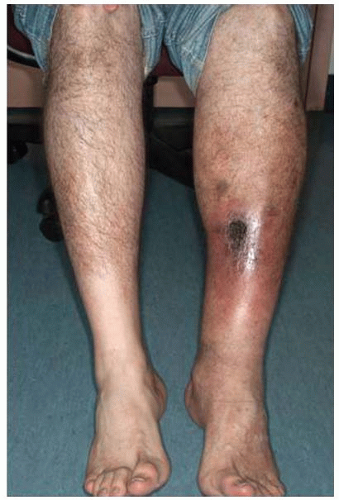POSTTHROMBOTIC SYNDROME
The postthrombotic syndrome (PTS) is an important, underrecognized, chronic sequela of deep vein thrombosis (DVT). PTS develops in 20% to 50% of patients with DVT,
1,2 even when appropriate anticoagulant therapy is used to treat DVT (see
Chapter 87). Clinical manifestations of PTS range from mild symptoms or signs to more severe manifestations such as intractable leg pain, severe edema, and leg ulcers that limit daily activity and ability to work.
3 PTS reduces quality of life and productivity,
4,5,6 and is costly as measured by health resource utilization, direct costs, and indirect costs.
7,8
PATHOPHYSIOLOGY OF THE POSTTHROMBOTIC SYNDROME
PTS occurs primarily as a consequence of venous hypertension, which in turn leads to reduced venous return, diminished calf muscle perfusion, impaired microvasculature function, and clinical manifestations of PTS.
9,28DVT leads to chronic venous hypertension by two principal mechanisms, persistent venous obstruction, and venous valvular reflux. Follow-up studies of patients with DVT who were treated with standard anticoagulants have shown that in many cases, there is only partial clearance of the thrombus.
29,30,31,32 Damage to venous valves with consequent valvular reflux is frequent after DVT, and is likely caused by thrombus-induced activation of inflammation, fibrous scarring associated with acute and resolving thrombosis, or venous dilation distal to the obstructed venous segment.
33,34,35,36,37 Residual venous obstruction 6 months after DVT, alone or in combination with valvular reflux, predicts the development of PTS, whereas reflux alone does not.
31,38Elevated levels of markers of inflammation (e.g., ICAM-1, interleukin-6, and C-reactive protein),
37,39 D-dimer,
40,41 and vein wall response to acute thrombosis
42 early after diagnosis or within a few months of DVT were associated with the development of PTS. A large, multicenter study is underway to prospectively assess the relationship between markers of inflammation and vessel injury and the development of PTS.
43
EPIDEMIOLOGY OF POSTTHROMBOTIC SYNDROME: INCIDENCE, RISK FACTORS AND PROGNOSIS
Data from contemporary prospective studies with 1 year or longer follow-up demonstrate that 20% to 50% of DVT patients will develop PTS and 5% to 10% will develop severe PTS, which may include venous ulcers.
1,2,14,41,44,45,46,47 In most cases, PTS develops within the first 1 to 2 years after DVT.
1,2It is difficult to predict which DVT patients will develop PTS. A key finding from a recent prospective cohort study of 387 patients with acute symptomatic DVT was that incomplete resolution of leg symptoms and signs by 1 month after DVT strongly predicted the development of PTS during the subsequent 2 years.
2 In addition, venous thrombosis of the common femoral or iliac vein (compared with distal or popliteal vein DVT),
2,41,47,48 previous or recurrent ipsilateral venous thrombosis,
1,2,41,45,49,50,51 higher body mass index,
2,46,47,52,53 and older age
2,45,46 are associated with a greater risk of developing PTS. One study reported that DVT patients who had subtherapeutic International Normalized Ratios (INRs) more than half of the time during the initial 3 months treatment with vitamin K antagonists had a threefold higher risk of developing PTS,
46 thereby reinforcing the importance of close monitoring of the intensity of oral anticoagulant therapy following the initial thrombotic episode. The risk of PTS is not influenced by the patient’s sex,
2 presence of the factor V Leiden, or the prothrombin mutation
2,47 or by the context of the initial DVT (i.e., unprovoked, secondary, or cancer related).
2,41,45,46In summary, extensive DVT, prior ipsilateral DVT, persistent venous symptoms 1 month after DVT, obesity, and older age appear to be robust clinical predictors of PTS. However, DVT patients without these features can also develop PTS.
Despite the common belief that patients with PTS have a uniformly poor prognosis, outcomes might be better than previously reported, with more than half of patients remaining stable or improving during long-term follow-up.
2,54,55,56 Currently, it is not possible to predict the course of PTS in individual patients.










